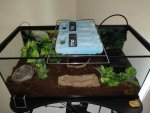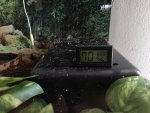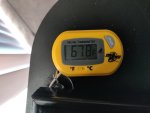phineasferb
New member
Good afternoon,
I wanted to run this by the long time keepers on this forum to see if there were any real benefits to using ice packs to keep vivarium temperatures cooler. From what I've gathered via the various websites, a temperature of 55-70 is a good range with the cooler side being ideal. My current house temperature sits between 73-75F and after placing the ice packs above the enclosure on a rack, the temperature inside the vivarium dropped a few degrees to about 67-68F. In addition, I found the water temperature to be around 64 degrees. I did this by placing digital temperature readers in the cage. Now, I understand they may not be the highest of quality readers but I think it provides a good estimate. I also do not find it feasible to change out the ice packs; however, it may be a solution for temporary power outages or for those who struggle to maintain a cool temperatures in their home. Any feedback is appreciated and welcomed!




I wanted to run this by the long time keepers on this forum to see if there were any real benefits to using ice packs to keep vivarium temperatures cooler. From what I've gathered via the various websites, a temperature of 55-70 is a good range with the cooler side being ideal. My current house temperature sits between 73-75F and after placing the ice packs above the enclosure on a rack, the temperature inside the vivarium dropped a few degrees to about 67-68F. In addition, I found the water temperature to be around 64 degrees. I did this by placing digital temperature readers in the cage. Now, I understand they may not be the highest of quality readers but I think it provides a good estimate. I also do not find it feasible to change out the ice packs; however, it may be a solution for temporary power outages or for those who struggle to maintain a cool temperatures in their home. Any feedback is appreciated and welcomed!




